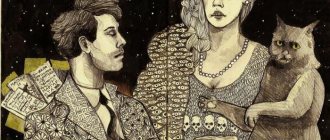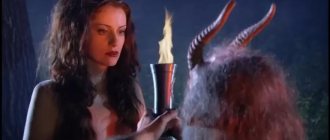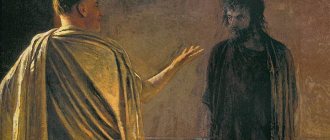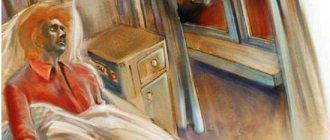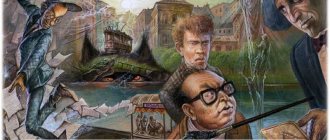“Menippean satire” in M. A. Bulgakov’s novel “The Master and Margarita”
The novel “The Master and Margarita” by Mikhail Afanasyevich Bulgakov is recognized as one of the greatest literary works of the 20th century. The novel is characterized by a deep philosophical meaning, a complex hierarchical structure of images, and a unique mythological text. The article interprets the genre of “Menippean satire” (as researcher M. M. Bakhtin pointed out at one time); this helps to reveal the unique artistic value and ideological essence of Bulgakov’s creation.
Key words: The Master and Margarita, Menippean satire, structure of the novel, poetics.
"Menippean satire" (or Menippean satire) is one of the classical narrative genres, derived from the name of the philosopher Menippus, who lived in the 3rd century BC. The term was first introduced in the 1st century AD by the Roman scholar Varro of Reatina, who theoretically substantiated the genre and its style. The genre of “Menippean satire” is characterized by the transition of characters into the realm of fantasy, for example, a journey to heaven, movement to the kingdom of the dead. The heroes leave the boundaries of their usual spheres of existence, which gives them the opportunity to free themselves from conventions. Characters acquire stable roles: talker, miser, fanatic, etc.
In the late period of the ancient era, a unique literary phenomenon emerged - a paradoxical combination of serious reasoning, fantastic images and comic inserts. This type of art also includes “Socratic dialogue,” which involves asking questions during the conversation. Asked questions activate the work of thinking, and as a result, the interlocutors understand the essence of things, that is, they come to the truth.
Socratic dialogue, like “Menippean satire,” is based on folk art; both genres also have a carnival nature. The term “carnivalization” was introduced by the outstanding researcher M. M. Bakhtin in the process of studying ancient and medieval folk festivals and rituals that influenced all subsequent art. "Menippean Satire" inherits the core of Socrates' dialogue - the desire for truth, which is born in a dispute and synthesized with elements of the comic.
Over time, “Menippean satire” is constantly updated and developed; it can penetrate different genres, combine their features, demonstrating the unique characteristics of its own genre. Its uniqueness is expressed in a satirical attitude towards reality, the passage of time, as well as bold assessments in relation to society. However, in different eras, “Menippean satire” had a common basis: the popular nature of laughter. M. M. Bakhtin analyzed the existence of the genre in question from the ancient Greek period to the 19th century (since its laws turned out to be universal) and examined the process of evolution of “Menippean satires,” highlighting four phases. “Menippean satire” showed its qualities at every phase of the development of art, constantly changing and at the same time maintaining the unity of its characteristics.
- At the initial stage of development, the “maternal nature” of the genre was manifested in the fact that it contained “serious laughter,” from which the basis of the folk “Menippean satires” came. At the same time, Socrates' dialogue, also based on folk art, penetrates the "Menippean satire", enriching its original form. "Menippean satire," defined by a culture of serious laughter, was based on a special conversational manner: dramatic debate, mockery and abuse. Mixed in here were elements of the philosophy of the Cynics, who preached simplicity of life and contempt for conventions.
- At the second stage, “Menippean satire” had a decisive influence on the formation of ancient Christian literature. The dialogue elements of Menippean satire have played an important role in various types of Christian literature, especially in the Gospels, which are based on a large number of dialogues. Contrasting dialogues, in which the “Menippean satire” presents the image of Christ, gives (adds) to them the function of revelation. There are such contrasting images as the tempter and the tempted, the followers and opponents of Christ, the poor and the rich. They come together to reflect the truth.
- The third stage is associated with the Middle Ages, when the “Menippian satire” continued to develop based on the traditions of ancient Christian literature. The main features of this literature are as follows: dialogue is combined with a “Menippean quarrel,” contradictions, and sarcasm. “Menippean satire” increasingly penetrated into mysterious religious dramas, adding elements of myth, Roman “agronomic genres”, while maintaining the harmony of all elements.
- At the fourth stage, after the onset of the Renaissance, “Menippean satire” was practically included in all large-scale works of the era. Various forms acquired in the process of development of certain social and cultural phenomena were combined. “Menippean satire” is present in the works of F. Rabelais and M. Cervantes, who interpret it and reproduce it in paradoxical grotesque forms. Ultimately, the genre paid tribute to rationalism and launched a brutal attack on ignorance during the Enlightenment, which gave a new color to ancient forms. For example, Voltaire in his philosophical novels used dialogue, close-up, and satire, characteristic of “Menippian satyrs.” “Memory of the genre” (to use Bakhtin’s term) was preserved and actively existed in romantic literature: the ironic stories of F. Fouquet and the philosophical works of E. T. A. Hoffman are the heirs of ancient forms, significantly enriched in subsequent eras.
The outstanding Russian thinker of the 20th century M. M. Bakhtin, whose field of research is very extensive (covers linguistics, poetry, history, psychoanalysis, philosophy, aesthetics), identified fourteen characteristics of “Menippean satire”. However, they represent an organic whole, reflecting the deep internal unity of the genre. The component of laughter, farcical scenes, the combination of contrast and contradiction are fully represented in M. A. Bulgakov’s novel “The Master and Margarita” (published in 1966).
- K component of laughter
Compared to Socrates' dialogue, "Menippean satire" enhances the "laughter" component and has a special carnivalesque character. As noted above, M. M. Bakhtin’s theory of carnival is based on the study of the folk culture of laughter.
"Carnival" is a unique container of laughter. M. M. Bakhtin believed that complete fearlessness cannot be joyless, and true joy and fear are completely compatible with each other. At the same time, “carnival” claims to eliminate one-sided seriousness. Seriousness and the official world (officialdom, bureaucracy) inevitably accompany each other. Through carnival, people can temporarily forget class differences, rank and rank. In laughter, all official prohibitions and religious restrictions temporarily disappear, freedom arises, and the boundaries of body and mind are destroyed.
The folk culture of laughter is universal and comprehensive; it is dual in nature. M. M. Bakhtin noted that this type of laughter has two aspects: even if it is joyful and positive, it also ridicules harshly at the same time. He can be both negative and sarcastic. Many phenomena that cannot be seen in serious areas can appear in the field of laughter.
All significant matters can contain the ingredient of laughter. Let us remember that in Bulgakov’s novel, on a hot evening, the President of the Council of the Moscow Writers Association Berlioz and the poet Ivan were sitting on a bench in the Patriarchal Park. They drank apricot juice with yellow foam and inhaled the smell of a hairdresser, while hiccupping constantly. Berlioz, as indicated in the work, is holding a very elegant cylinder (like a pie) in his hands.
These details (yellow foam, barbershop-scented apricot juice and cakes) are extremely joyful in nature. The author ironically notes that members of the Moscow Writers Association, even I. Kant, did not know; they focused exclusively on the food served in the restaurant. The poet Ivan Bezdomny had never heard of the opera Faust, although, as a man of art, it would seem that he should be educated. Berlioz is smart enough, but he does not understand that the man he met is Satan himself. The decision to take over the nephew’s house after his death, the “ruble rain”, and the farcical scene in the store (for all its tragedy) are full of comedy; these scenes reveal the lack of spirituality and immorality of the characters.
- Farcical scenes _ _ _
Farces, depictions of strange behavior, absurd speeches that contradict common sense, the code of decent behavior, and polite etiquette are very typical for “Menippean satires.” In The Master and Margarita, Woland and his retinue staged funny and extremely provocative scenes in Moscow.
A “ruble rain” happened in a Moscow theater, a women’s goods store was opened, women climbed onto the stage to take off their clothes and put on fashionable Parisian clothes. Woland described this phenomenon as follows: “People are like people. They love money, but this has always been the case... Humanity loves money, no matter what it is made of, whether leather, paper, bronze or gold. Well, frivolous... well, well... ordinary people... in general, they resemble the old ones... the housing issue only spoiled them...”
After the magic show, the ruble turned into trash, the lady's clothes disappeared, and there were women in their underwear everywhere on the street. But the day after the performance there was a long line at the theater box office, as everyone wanted to buy theater tickets. Greed and vanity have overcome common sense.
- With a combination of contrast and contradiction I
The combination of contrast and contradiction is also a technique of “Menippean satires” that left their mark in Bulgakov’s novel. In “The Master and Margarita” we see how freedom of spirit and enslavement of the body, immorality and high purity coexist. In the work under consideration, seemingly incompatible things are combined, which creates a poetics of duality, fully represented in the works of F. M. Dostoevsky, the forerunner of Bulgakov.
In "The Master and Margarita" the space-time models (chronotope) are contrasting. The time of the appearance of Jesus (cruel, marked by executions and persecutions, the 1st century AD) and the Stalinist era (also not distinguished by humanism) are contrasted. It turned out that two distant time layers have a lot in common - this is how aesthetic symmetry in history manifested itself.
There are some parallels between the Master, Woland and Jesus. Jesus is an intelligent and humane philosopher who brings goodness and tolerance to the world (he calls everyone a “good person”). The master is a seeker of truth, he used all his wisdom and courage in his novel about Pontius Pilate to fight the atheism that was popular in Soviet society at that time. Despite his appearance as a devil, Woland is a defender of justice. The farcical scenes staged by him and his retinue highlighted the vulgar sides of human nature and the shortcomings of the social ideological system. Woland’s statement, which became a catchphrase: “What would your good do if evil did not exist?” - emphasizes the dialectical unity of two fundamental concepts.
Conclusion
“The Master and Margarita” is a philosophical novel that allows the reader to think about his responsibility to the world, about life and death, about life after death. Before us is a novel of contrasts, as it juxtaposes biblical motifs and diabolical images. M. A. Bulgakov, perhaps, became the first writer who placed the opposite concepts so closely. With all the difficulties of life depicted, the writer managed to instill optimism in the reader: although Jesus died, his kind heart will always support those who suffer; The master died, his manuscript was destroyed, but the great novel by M. A. Bulgakov will remain a storehouse of wisdom and spirituality. As you can see, art in general and literature in particular help humanity remember the lessons of history: condemn cruelty, persecution, executions.
Such an aesthetic picture was helped to create by “Menippean satire,” the oldest genre form that excludes “one-sided seriousness” and makes it possible to combine the comic and tragic, irony and heroic pathos. M. M. Bakhtin called this property “ambivalence” - the synthesis of low and high, life and death, laughter and harsh condemnation. Having seen in folklore carnival a manifestation of great wisdom (developed over centuries), the researcher revealed many laws of fiction.
Literature:
- Bakhtin M. M. Poetics of Dostoevsky [M]. Translated by Bai Chunren, Gu Yaling. Xinji Sanlian Bookstore, 1988.
- Wu Chengdu. Review of Bakhtin's theory of poetics - from sociological poetics to cultural poetics [M]. Chilu Book Club, 2009.
- Bakhtin M. M. Bai Chunren, translation by Gu Yaling. Poetics and interviews [M]. Shijiazhuang: Hebei Education Press, 1998.
- Bulgakov M. A. Translation by Gao Huiqun. The Master and Margarita [M]. Shanghai: Shanghai Translation Publishing House, 2007.3.
- Wu Qifang. A study of the body characteristics of Menippus in the creation of Dostoevsky's stories [D]. Heilongjiang University, 2021.
- Wang Jiangang. Carnival poetics [M]. Shanghai: Xiulin Publishing House, 2001.
- Cheng Zhenmin. Cultural poetics of M. M. Bakhtin [M.]. Beijing: Beijing Normal University, 2001.
- Qi Qi. “The Master and Margarita” and “Menipit” Literature [J]. Foreign Languages, 2021, 2 (04): 2–7.
Satire in the novel by M.A. Bulgakov "The Master and Margarita"
In his novel “The Master and Margarita” M. Bulgakov combines two levels of narrative: philosophical and satirical. The first line is connected with the biblical plot, the second - with the depiction of the morals of the society contemporary to the author. The tone and storytelling techniques in them have sharp differences.
Bulgakov's Moscow is depicted mainly in satirical colors. This is due to vulgarity, opportunism, and selfish interests of its inhabitants. All these qualities determine the satirical tone of the story. The complex structure of the novel with an extensive system of characters allowed the author to mask the satirical pathos of the work as much as possible. This allows Bulgakov to present a complex picture of Moscow morals in the 1920s.
The writer subtly combines the grotesque and fantasy. Here he acted as a continuer of Gogol’s traditions. This was especially evident in the use of detailing. It was this detail that allowed the writer to highlight the essence of the character being portrayed and at the same time acted as a means of creating the grotesque.
Usually M. Bulgakov uses everyday, portrait and symbolic details. They give the necessary authenticity to what is happening (“a hefty black cat, the size of a hog,” hanging on the footboard of a tram with a ten-kopeck piece in his paw for the fare).
A striking satirical detail in the novel is a membership card to MASSOLIT. Formalities and benefits of position replaced the true work of the writer. The material thing came to the fore here: “a brown ticket that smells of expensive leather.” At that time, MASSOLIT was one of the most influential organizations in literature. But far from the most talented writers and poets worked there. This is evidenced by their “talking names”: the novelist Beskudnikov, the poet Dvubratsky, the writer Nastasya Lukinichna Neprimenova under the pseudonym “Navigator Georges”, the screenwriter Glukharev, the poetess Tamara Crescent, Zhukolov the novelist, “some Vitya Kuftik from Rostov, it seems, a director, with lilac lichen all over the cheek,” Pavianov, Bogokhulsky, Sladky, Shpichkin, Adelfina Buzdyak, etc.
This whole galaxy of “outstanding writers of their time” appears before us in the Griboyedov restaurant in a pointedly vulgar form: it is here that they enjoy all the benefits and privileges that the state gave them. The country's literary elite is shown to be mediocre, petty, and disgusting. Notable in this regard is the dance scene in this restaurant: the writers are spinning in a meaningless whirlwind. These figures are aimed not at creation, but at consumption. That is why, following Gogol, the author devotes a special place to the description of the table and various dishes for the MASSOLIT figures: “sterlet in a silver saucepan”, “arranged crayfish necks”, “fresh caviar”, “cocotte eggs with champignon puree in cups”, “ blackbird fillets”, etc. One important author’s remark speaks about the base interests of this society: “Not a single stream of fresh air penetrated the open windows,” “it smelled of onions.”
But of all this galaxy, Mikhail Afanasyevich Berlioz, who appears more than once in the novel, gets the most credit. His image tragically expresses one of the main ideas of the novel - “everyone gets something according to their faith.” This hero is punished for his selfish attitude towards people, faith, ideals, for his helpfulness, position as an opportunist, conceit, indulgence in stupidity, mediocrity. It is no coincidence that he is the head of MASSOLIT.
The theme of the satirical depiction of Moscow inhabitants is closely connected in the novel with the image of Woland. Together with his assistants, he disturbs their everyday life and exposes the absurdity of Soviet institutions. Here the writer follows Saltykov-Shchedrin. Both artists condemned formalism and unscrupulousness in the sphere of officials. One of the clearest confirmations of this is the image of a suit that, without a bureaucratic owner, independently makes resolutions.
M. Bulgakov successfully uses Gogol's fantasy (scenes of the Sabbath, flights on a hog-man). In his novel, the writer ridicules the vices of individuals (the drunkenness and debauchery of the director of the variety show Styopa Likhodeev, the carelessness of his assistant Varenukha, the indifference and bureaucracy of the chairman of the housing association of building No. 302 bis Nikanor Ivanovich Bosogo, the unscrupulousness of Rimsky, etc.).
The meager life of Muscovites is emphasized by the description of what is stated in complaints to the chairman of the housing association: slander, denunciations, theft of dumplings, etc. Indicative in this regard are sessions of black magic and its revelations. Despite Bengalsky’s ingratiation, Woland notes that Muscovites have changed a lot in appearance, they have cars, trams and other inventions, but their morals have remained the same: “the housing issue has spoiled them.”
M. Bulgakov subtly notices the change in the crowd as Woland performs his magical actions. The most exciting attraction for them is money falling from the ceiling of the hall. This is where their true nature emerged. There was chaos and noise. All the spectators' eyes sparkled. For fun, they suggested tearing off Bengalsky's head.
The whole scene resembled mass hypnosis. People are accustomed to living in myths and illusions. M. Bulgakov depicts this using the technique of fiction. Woland gave each lady the opportunity to dress in the outfit she liked. But, leaving the theater, the magnificent ladies were horrified to discover that they were completely naked.
With the thirst for money and social status, people have lost their minds. They became easy to manipulate and mislead. It is no coincidence that the motive of exposing ordinary people echoes the motive of madness (the image of Ivan Bezdomny, Nikonor Ivanovich Bosogo). The Stravinsky Clinic where they end up resembles the entire modern world.
But, satirically depicting eternal human vices, M. Bulgakov hopes for their correction and human improvement. Everyday and mythological scenes of the novel indicate that the spiritual and the non-spiritual have always fought in man. It is no coincidence that Woland’s statement about this became popular in the novel: “They are people like people. They love money, but that’s always been the case... Well, they’re frivolous... Well, well... and mercy sometimes knocks on their hearts.” The author shows that human improvement lies, first of all, in his moral beginning.
The originality of M. Bulgakov's satire is manifested in the fact that it is not of a narrowly temporary, fragmentary nature, but, on the contrary, expresses a broad, universal view of man. M. Bulgakov does not put satire at the heart of his novel. It is closely intertwined with moral and philosophical problems that have always faced man. Based on the rich literary traditions of his predecessors and introducing innovative elements, M. Bulgakov creates his own unique artistic style.
